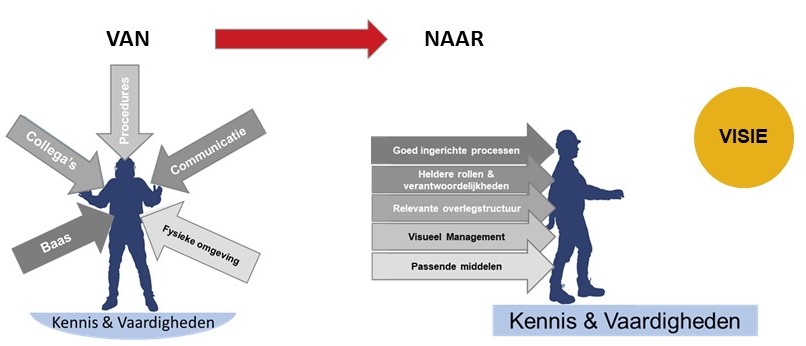WAAROM ORGANISATORISCHE ALIGNMENT?
We leven in een tijd van ongekende verandering en onzekerheid. Als bedrijf in deze tijd succesvol zijn, vraagt alert acteren op situaties en daarbij net een stapje voor te lopen op de markt. Dat kan alleen als afdelingen goed op elkaar zijn aangesloten en snel met elkaar meebewegen bij noodzakelijke korte termijn aanpassingen; zonder de langere termijn uit het oog te verliezen.
Het is wat dat betreft goed vergelijkbaar met een zwerm spreeuwen. Zij vliegen dicht bij elkaar en even snel. Ook houdt een spreeuw maximaal zeven buren in de gaten en reageert razend snel op een verandering van richting van zijn buren. Daardoor kan de zwerm zonder botsingen snel bewegen en van richting veranderen om problemen voor te zijn.
Hun korte termijn veranderingen van richting zijn geen teken van opportunistisch gedrag. Het kan een reactie op bijvoorbeeld een aanvallende roofvogel zijn. Het uiteindelijke doel is helder en wordt gehaald.
WAT IS ORGANISATORISCHE ALIGNMENT?
Organisatorische alignment betekent dat visie, strategische doelen, targets, het operating model, het gedrag en de vaardigheden van de mensen in de organisatie met elkaar in lijn zijn. In onderstaande figuur is dit uitgebeeld.
HOE ORGANISATORISCHE ALIGNMENT TE REALISEREN?
AANSPREKENDE VISIE
Alignment begint met een aansprekende visie, waarvan iedereen in het bedrijf zich mede-eigenaar voelt. Een visie die verbindt en enthousiasmeert en de verschillende populaties binnen het bedrijf aanspreekt.
Dat is niet een kwestie van een aantal sessies met het leiderschapsteam en bedrijfsbrede communicatie. Het is een reis die wel aan de top start, maar dan door alle niveaus van de organisatie gaat. Aan het einde van die reis staat een visie waaraan iedereen zijn bijdrage heeft geleverd, zich in herkend en voor wil gaan.
Een visie is overigens niet statisch en zal zich door ontwikkelen in lijn met de ontwikkelingen in onder andere technologie, de markt, de maatschappij. De mensen in de organisatie hebben daarbij wel behoefte aan voldoende vastigheid. Daarom bestaat een aansprekende visie uit een vast deel dat altijd blijft en een variabel deel dat zich altijd door ontwikkelt.
STRATEGISCHE DOELEN
Hoe aansprekend een visie ook is, die is relatief nutteloos als deze zich niet vertaalt in een set strategische doelen met targets (KPI’s – Kritieke Prestatie Indicatoren) waarop gestuurd wordt. En niet alleen aan de top van de organisatie, maar op alle niveaus tot en met de werkvloer.
Dit proces van cascaderen van doelen en targets is een delicaat proces. De doelen en targets aan de top van het bedrijf moeten behaald worden en tegelijk moeten afdelingshoofden en teamleiders hun afgeleide doelen en targets wel accepteren. Goed inzicht in de huidige prestatie, de formulering van SMART doelen (Specific, Measurable, Achievable, Realistic en Time based) en een zorgvuldige dialoog ondersteunen het acceptatieproces. Oprecht eigenaarschap van de doelen en targets is een belangrijk deel de basis voor de realisatie van die targets.
VERANKEREN IN HET DAGELIJKSE RUNNEN VAN DE BUSINESS
Vervolgens worden de plannen en targets verankerd in de manier waarop de organisatie van dag tot dag draait. Dat vraagt transparantie van actuele prestatie tegen KPI-targets en een houding en gedrag die actuele prestatie naar KPI-target drijft.
Een operating model dat in lijn is met de visie en strategische doelen levert die transparantie en ondersteunt de ontwikkeling en het behoud van een effectieve houding en gedrag.
ORGANISATORISCHE ALIGNMENT – DE SLEUTEL TOT SUCCES
Als visie, strategische doelen, targets, het operating model, het gedrag en de vaardigheden van de mensen met elkaar in lijn zijn, kan de organisatie snel en adequaat veranderende omstandigheden navigeren zonder haar langer termijn doel uit het oog te verliezen en haar ambitie realiseren.




